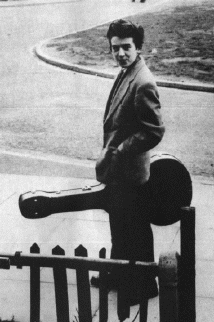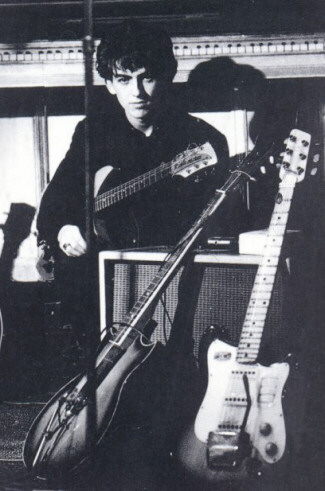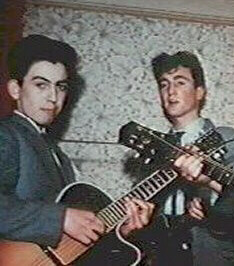The Guitarist
 It's fair to say George Harrison didn't just
waltz into the Beatles' lead guitar slot.
Through talent and tenacity, he earned it.
Harrison was the funny-looking, skinny chap Paul
McCartney used to see on the bus to school.
He had a flair for colorful clothes and, above all, a
love of the guitar, which he shared with the slightly
older McCartney. In 1958, with nothing more
impressive on his resume but one gig at the British
Legion Club with his brother Peter and a couple mates,
the 15 year old began sitting in with the group
McCartney had just joined -- The Quarry Men -- and
filled in when one or another of the guitarists didn't
show. Before long his chops -- honed from arduous
practice and careful devotion to R&B and Country and
Western hits from America -- won him a permanent
position as the band's go-to guy. During a lean
period in 1959 Harrison played with the Les Stewart
Quartet but by August he was back with the Beatles to
open the Casbah Club, and for every gig they played
thereafter. It's fair to say George Harrison didn't just
waltz into the Beatles' lead guitar slot.
Through talent and tenacity, he earned it.
Harrison was the funny-looking, skinny chap Paul
McCartney used to see on the bus to school.
He had a flair for colorful clothes and, above all, a
love of the guitar, which he shared with the slightly
older McCartney. In 1958, with nothing more
impressive on his resume but one gig at the British
Legion Club with his brother Peter and a couple mates,
the 15 year old began sitting in with the group
McCartney had just joined -- The Quarry Men -- and
filled in when one or another of the guitarists didn't
show. Before long his chops -- honed from arduous
practice and careful devotion to R&B and Country and
Western hits from America -- won him a permanent
position as the band's go-to guy. During a lean
period in 1959 Harrison played with the Les Stewart
Quartet but by August he was back with the Beatles to
open the Casbah Club, and for every gig they played
thereafter.  In a solo career populated by both worldwide hits and spectacular misses, Harrison has earned the respect of fans, musicians and critics alike with his unique palette of humor, devotion, irony and craftsmanship. "I believe I love my guitar more than the others love theirs," Harrison once told Beatles Monthly. "For John and Paul, songwriting is pretty important and guitar playing is a means to an end. While they're making up new tunes I can thoroughly enjoy myself just doodling around with a guitar for a whole evening. I'm fascinated by new sounds I can get from different instruments I try out. I'm not sure that makes me particularly musical. Just call me a guitar fanatic instead, and I'll be satisfied ." |
 1956: Egmond steel-strung Spanish style
(sunburst, vintage unknown): In one account,
Harrison bought this "Beginner's Guitar," made in
Holland by Egmond and distributed by Rosetti, from a
schoolmate with £3 he'd gotten from Mum. In
another account, his dad got it for £2.50.
The
1956: Egmond steel-strung Spanish style
(sunburst, vintage unknown): In one account,
Harrison bought this "Beginner's Guitar," made in
Holland by Egmond and distributed by Rosetti, from a
schoolmate with £3 he'd gotten from Mum. In
another account, his dad got it for £2.50.
The 
 1958: Hofner President f-hole acoustic
(vintage unknown): In a quantum leap from his first
instrument, and with a little help from Mum, Harrison
purchased this handsome Hofner, a top-of-the-line,
single-cutaway "cello style" model with a sunburst
finish and a "Compensator" tailpiece, for
£30. He played the President until swapping
it to a member of the Swinging Blue Jeans the following
year for a Hofner Club 40.
1958: Hofner President f-hole acoustic
(vintage unknown): In a quantum leap from his first
instrument, and with a little help from Mum, Harrison
purchased this handsome Hofner, a top-of-the-line,
single-cutaway "cello style" model with a sunburst
finish and a "Compensator" tailpiece, for
£30. He played the President until swapping
it to a member of the Swinging Blue Jeans the following
year for a Hofner Club 40.